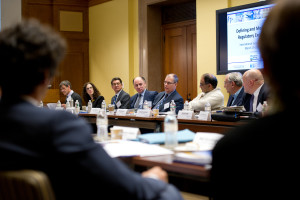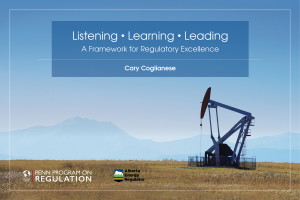
Report commissioned by Alberta Energy Regulator defines regulatory excellence.
University of Pennsylvania Law School professor Cary Coglianese issued today his final report of the Penn Program on Regulation’s Best-in-Class Regulator Initiative, an effort commissioned a year ago by the Alberta Energy Regulator (AER) to define regulatory excellence and offer recommendations to regulators around the world about how they can improve and measure their regulatory performance.
The AER is the single regulator of energy development in Alberta, Canada, and is responsible for the safe and environmentally responsible development of oil, natural gas, coal, and oil sands throughout the province.
The Penn Program on Regulation (PPR) was chosen to lead the AER’s Best-in-Class Project last year through a competitive, international selection process. As part of the project, PPR convened four major dialogue sessions that involved more than 150 participants, both with groups of international experts as well as interested members of a cross-section of the Albertan public. In addition, Professor Coglianese and other members of the PPR team conducted interviews with more than 60 individuals interested in the work of the AER. In total, Coglianese commissioned and oversaw the production of more than 35 research papers during the course of the project.
Coglianese’s final report, entitled “Listening, Learning, Leading: A Framework for Regulatory Excellence,” is the capstone to the overall initiative.
“This report imparts real wisdom about how to improve regulation,” said Ted Ruger, Dean of Penn Law. “This report, along with the other first-rate research produced as part of this project, will become a necessary resource for regulators, policymakers, and scholars for years to come.”
“We found that excellence in regulation requires much more than effective technical and analytical skill,” said Coglianese, who is the Edward B. Shils Professor of Law and Professor of Political Science and the director of the Penn Program on Regulation. “The report shows how regulatory excellence also depends vitally on what might be called ‘people excellence.’”
Drawing on the extensive research and outreach conducted in the course of the project, Coglianese found that regulatory excellence can be distilled to three essential attributes: (1) utmost integrity; (2) empathic engagement; and (3) stellar competence. These attributes, which Coglianese refers to as a “RegX molecule,” support nine tenets of regulatory excellence emphasized in the report.
“We found that many regulators focus solely on improving technical competence, which they definitely should,” Coglianese said. “But around the world, they also need to ensure that they interact fairly and respectfully in the service of their entire publics.”
To inform the final report, PPR team members and outside experts produced an original study of regulators’ strategic plans along with five other major research papers that synthesize existing research on key facets of regulatory operations. In addition, PPR commissioned leading experts from around the world to produce a series of papers on what makes a regulator excellent that will be published next year by the Brookings Institution Press.
In the just-released final report, Coglianese offers a framework for excellence that can be practically applied by the AER and other regulators. He shows that to achieve excellence regulators must align their traits, actions, and outcomes with the core attributes of regulatory excellence. He then develops a model of regulatory organization, action, and performance to guide regulators that seek to achieve excellence.
 The report also discusses major issues regulators face in seeking excellence, including organizational independence, performance-based and risk-based regulation, incident response, and methods for promoting transparency and public participation.
The report also discusses major issues regulators face in seeking excellence, including organizational independence, performance-based and risk-based regulation, incident response, and methods for promoting transparency and public participation.
To help regulators track their progress toward excellence, the report recommends that regulatory leaders institute systems for measuring regulatory performance. While the report makes a point to note that no single measure can capture all that a regulator must accomplish to become excellent, it does recommend regulators institute regular systems for measuring progress in addressing specific problems and for helping policymakers understand patterns and trends in how the regulatory organization is doing as a whole. It urges regulators to think strategically about developing a measurement portfolio that also includes careful evaluations designed to determine if regulations and programs are having their intended effects.
The report offers five major recommendations for any regulator who seeks regulatory excellence, urging their leaders to align strategic priorities and organizational cultures around the core attributes of regulatory excellence. “To be truly excellent, regulators around the world must meet the challenge of building highly competent, empathic, and public-spirited workforces,” Coglianese said.
The report also stresses the importance of regulators involving the public in all facets of their operations, from developing strategic plans, establishing regulatory directives, and developing measurement systems.
Coglianese concludes the report by emphasizing that an excellent regulator is always learning and striving to improve.
“The excellent regulator cannot stay in one place, content to have mastered solving the problems of the past,” Coglianese writes. “The world changes, its problems change, its economies change, and its social concerns change. Excellence as a regulator requires forward momentum, not static achievement.”
The full text of the final report can be found here.
This is part one of a three part series highlighting the release of the Best-in-Class Regulator Initiative’s final report.




